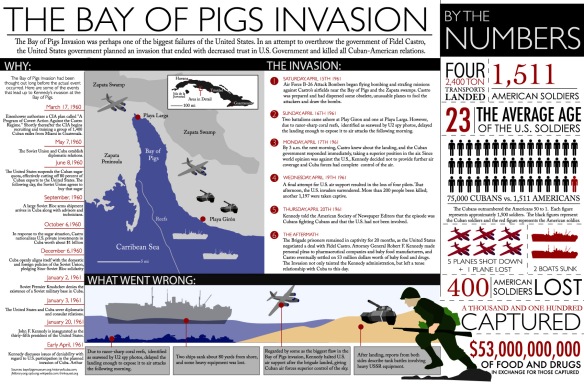One of the 5 tanks M41 of the 2506 Brigade that landed in Bay of Pigs, are exhibited today in the Girón Beach Museum.
In the spring of 1960, President Dwight Eisenhower approved a covert operation to send small groups of American-trained Cuban exiles to work in the Cuban underground as insurgents to overthrow Castro. President Eisenhower had soured on Castro after the latter nationalized a number of Cuban companies and began leaning toward the Soviet orbit of influence. There were also rumors of Cuban involvement in attempts to invade Panama, Guatemala, and the Dominican Republic. In 1960, the United States turned down Castro’s request for economic aid and broke off diplomatic relations with Cuba. After the American rejection, Castro met with Soviet foreign minister Anastas Mikoyan to secure a $100 million loan from the Soviet Union. U. S. policymakers thus decided that Castro was becoming too close to the Soviets and should be overthrown.
By the fall, the plan, called Operation Pluto, had evolved into a full-fledged invasion by exiled Cubans, and included U. S. air support. The rebels of Brigade 2506, as they were called, deployed to Guatemala to train for the operation, under the leadership of the Central Intelligence Agency (CIA) with arms supplied by the U. S. government.
When President John F. Kennedy assumed office in January 1961, he could have called off the invasion but chose not to do so. During the 1960 presidential campaign, Kennedy had criticized Eisenhower’s handling of the Cuban situation and so did not find it politically expedient to back down from the invasion. Kennedy was also anxious to prove his hawkish stance toward the Soviets during a period of heightened Cold War tensions. But the new president was not well served by the CIA or its director, Allen W. Dulles, whom he inherited from the Eisenhower administration. The agency grossly underestimated the effectiveness of Castro’s forces and overplayed the extent to which Cubans would rally behind the invasion force.
On April 17, 1961, an armed force of approximately 1,500 Cuban exiles landed in the Bahia de Cochinos (Bay of Pigs) on the southern coast of Cuba, although the invasion had technically commenced two days earlier when American B-26 medium bombers with Cuban markings bombed four Cuban airfields. The invasion began at 2:00 a. m. when a team of frogmen went ashore with orders to set up landing lights to guide the main landing force. Between 2:30 and 3:00 a. m., two battalions of exiles armed with American weapons came ashore at Playa Giron, while another battalion landed at Playa Largas. They hoped to find support from the local population, intending to cross the island to attack Havana. Cuban forces reacted quickly, and Castro ordered his air force to halt the invaders. Cuban aircraft promptly sank the invading force command-and- control ship and another supply vessel carrying an additional battalion. Two other ships loaded with supplies, weapons, and heavy equipment foundered just offshore. In the air, Cuban T-33 jets shot down 10 of the 12 slow-moving B-26 bombers that were supporting the invaders. President Kennedy, on the recommendation of Secretary of State Dean Rusk and other advisors, decided against providing the faltering invasion with official U. S. air support.
Lacking supplies or effective air cover, the invaders were hammered by Cuban artillery and tank fire. Within 72 hours, the invading force had been pushed back to its landing area at Playa Giron, where the troops were soon surrounded by Castro’s forces. A total of 114 exiles were killed, and the remainder of the invasion force either escaped into the countryside or was taken captive. In all, 1,189 captured exiles were tried in televised trials and sentenced to prison.
Cuban exile leader José Miro Cardona, president of the U. S.-backed National Revolutionary Council, blamed the failure on the CIA and Kennedy’s refusal to authorize air support for the invasion. In December 1962, Castro released 1,113 captured rebels in exchange for $53 million in food and medicine raised by private donations in the United States.
The Bay of Pigs invasion provoked anti- American demonstrations throughout Latin America and Europe and further embittered U. S.-Cuban relations. The poorly planned and executed invasion greatly embarrassed President Kennedy and subjected him to heavy criticism at home. More important, it led directly to increased tensions between the United States and the Soviet Union. During the invasion, Kennedy and Soviet Premier Nikita Khrushchev exchanged messages regarding the events in Cuba. Khrushchev accused America of being complicit in the invasion and warned Kennedy that the Soviets would help defend Cuba if necessary. Kennedy replied with an equally strong warning against any Soviet involvement in Cuba. Although the crisis quickly passed, it set the stage for increased Soviet military aid to Cuba, which led ultimately to the Cuban Missile Crisis in October 1962. The failure of the invasion led to the resignation of Dulles and opened the way for closer scrutiny of U. S. intelligence gathering.
Further Reading Higgins, Trumbull. The Perfect Failure: Kennedy, Eisenhower, and the CIA at the Bay of Pigs. New York: Norton, 1989. Kornbluh, Peter. Bay of Pigs Declassified: The Secret CIA Report on the Invasion of Cuba. New York: New Press, 1998. Meyer, Karl E., and Tad Szulc. The Cuban Invasion: The Chronicle of a Disaster. New York: Praeger, 1968. Rusk, Dean. As I Saw It. New York: Norton, 1990. Wyden, Peter. The Bay of Pigs: The Untold Story. New York: Vintage/Ebury, 1979.
